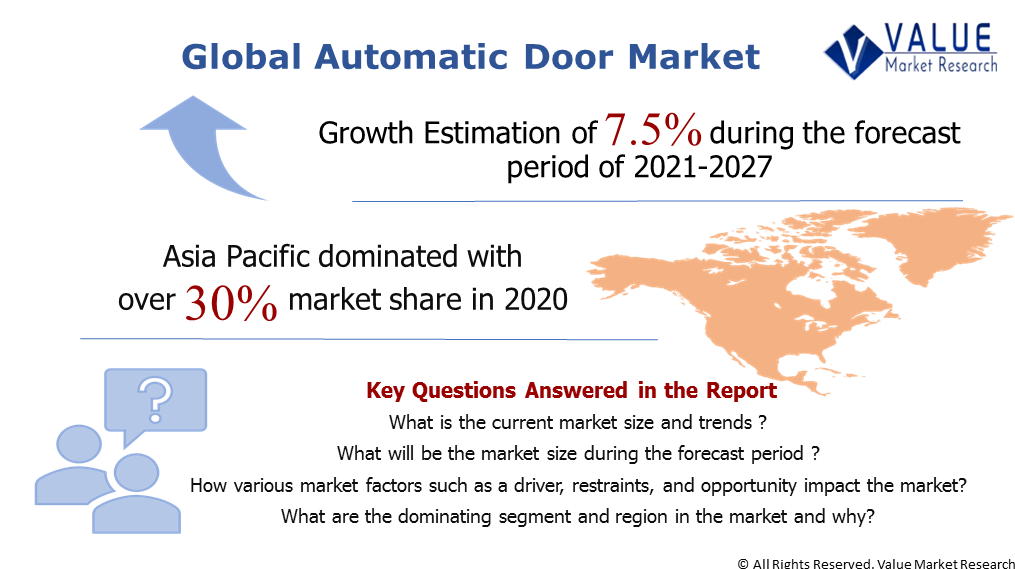Global Automatic Door Market Overview
The key driver impacting the automatic door market is the growing construction sector across the globe. The rise in construction or infrastructural development activities, specifically in emerging economies, is anticipated to boost automatic door demand in the forecast period. For instance, As per the Oxford economics, Global Construction 2030 report, it is expected that the total construction output volume will augment by 85% to $15.5 trillion worldwide by 2030. The growth is majorly driven by three countries India, China, the US, and these three countries are responsible for 57% of all global growth. The residential housing sector represents 38% of global construction volume; energy, transport, and water infrastructure account for 32%; commercial buildings and institutional buildings represent 18%, and industrial sites (from cement to automotive manufacturing) have a share of 13%. Moreover, the growing installation of automatic doors across shopping malls, hotels, hospitals, corporate offices, laboratories, etc., is also a significant determinant that adds growth to the market.
According to Value Market Research, the global automatic door market was valued at around USD 24 billion in 2020 and is estimated to grow at a CAGR of about 7.5% during the forecast period of 2021 to 2027.
The rise in the development of smart cities in developing countries is estimated to augment market demand in the forecast period. For instance, as per the world bank report, China has launched a US$70 billion “smart city” credit line and an US$8 billion investment fund. Similarly, India is looking to leverage its homegrown information technology (IT) industry to build 100 smart cities, with a first-year budget of US$1.2 billion. however, the high cost of maintenance may hamper the global automatic door market in the long run. also, lockdowns imposed by governments of several countries are negatively impacting the market growth. the current industry trends, such as the growing need for safety across large organizations and the increasing construction of malls, high technology airports, grand hotels, and multiplexes, are expected to provide profitable market opportunities for the market players.
The automatic door market is vast, with many local and global players. the key leaders follow different strategies to improve their market position, such as contracts, mergers, contracts, extending product portfolio, acquisitions, expansions, and product innovations to improve their market share globally. the major players included in the report are ASSA ABLOY Entrance Systems, Record, Manusa, STANLEY Access Technologies LLC, Deutschtec, Holux GmbH, Matz-Erreka S.Coop, GU Automatic GmbH, GEZE GmbH, and Dormakaba Group.
 In this research report, the automatic door market is segmented by door type, end-user, and region.
Analysis by Door Type:
In this research report, the automatic door market is segmented by door type, end-user, and region.
Analysis by Door Type:
By door type, the report is categorized into the automatic sliding door, automatic circular Door, automatic swinging door, automatic revolving door, automatic folding door, other (Low Energy Swinging Door etc.) The pharmaceutical sector dominates the application segment with over 30% share in 2020. It is due to the high adoption of automatic sliding mechanism in residential buildings, hotels, offices, apartments, big retail outlets, airports, and other building projects. Moreover, the increase in adoption of sliding automatic doors among consumers and the rise in new construction and home improvement activities contribute to the vast market demand from the application sector in the forecast period.
Analysis by End-User:
By end-user, the report is categorized into residential, commercial, and industrial. The commercial sector dominates the end-user segment with over 40% share in 2020. It is due to the rise in usage of automatic panel doors and sliding doors in infrastructure projects and housing & commercial buildings. Moreover, the rising construction of hotels & restaurants, cafes & bars, resorts, government & corporate offices, and hospitals contributes to the vast market demand from the commercial sector in the forecast period.
Analysis by Region:
In the regional outlook of the global automatic door market, the Asia Pacific region dominates with a 30% market share during the forecast period. It is due to the growing demand for residential construction and infrastructural development across India, Japan, China, Singapore, Australia, and other Southeast Asian countries. Moreover, the rapidly growing construction sector and the adoption of automation across industries contribute to the development of the automatic door market across Asia Pacific.
Market Segmentation covered in the Report:
By Door Type
- Automatic Sliding Door
- Automatic Circular Door
- Automatic Swinging Door
- Automatic Revolving Door
- Automatic Folding Door
- Other (Low Energy Swinging Door etc.)
By End-User
- Residential
- Commercial
- Hotels & Restaurants
- Cafes & Bars
- Resorts
- Government & Corporate Offices
- Hospitals
- Salons & Beauty Spas
- Others (Laboratories etc.)
- Industrial
By Region
- North America
- Europe
- The Asia Pacific
- Latin America
- The Middle East and Africa
In case you have any custom requirements, do write to us. Our research team can offer a customized report as per your need.

